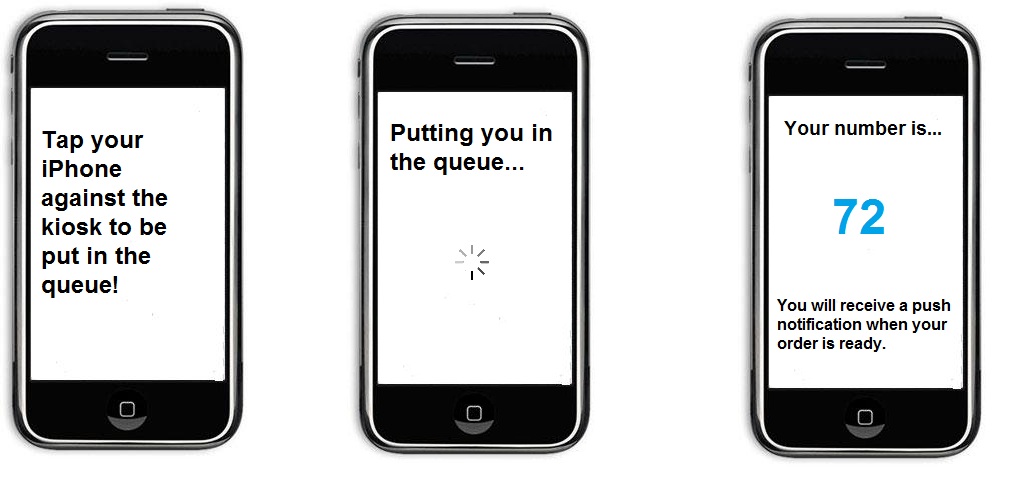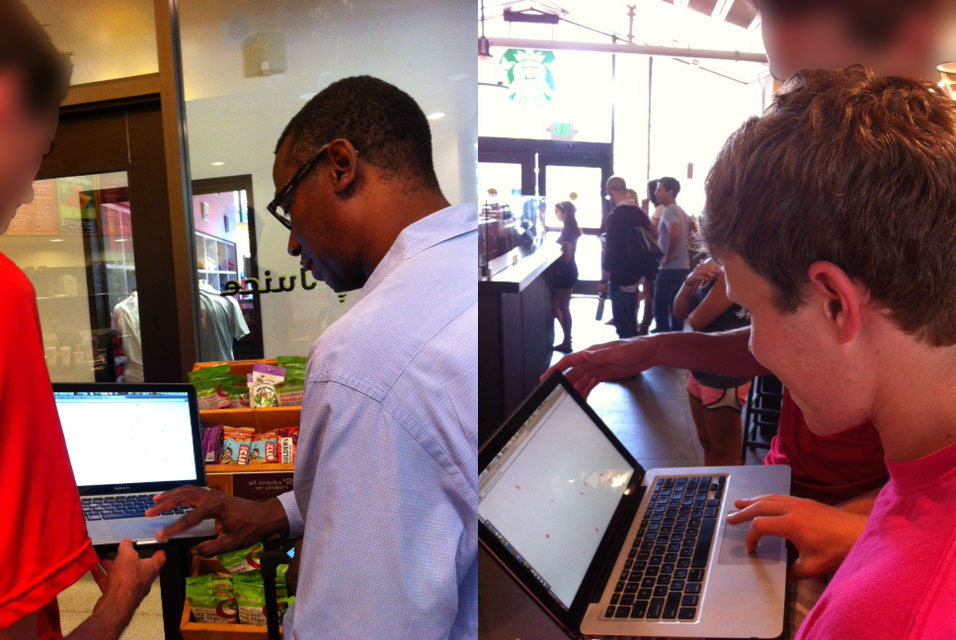Assignment 1, Example 2
Brainstorming
Making Line Waiting More Fun
- Set up line next to wall on which people can make shadow art (similar to the EMP's shadow wall: http://www.youtube.com/watch?v=Wj4XkoMWjdI).
- Project virtual aquarium on the wall and/or floor that people can interact with.
- Turn the wall and/or floor into a virtual keyboard.
- Project virtual percussion instruments on the wall and/or floor that people can play.
- Have a bunch of TV screens that people can change the channels of (maybe give them wireless headphones so they can tune in to one particular screen).
- Have a virtual game show that people can participate in while waiting.
- Project images of things on the wall that display information about themselves when touched (like a virtual mini-encyclopedia).
- Project a communal game of space invaders on the wall. People fire lasers by touching the wall in some way while they wait.
- Cover the wall in paper and make crayons readily available so people can doodle.
- Have people wait in rolling chairs instead of standing.
- Have people wait on exercise balls instead of standing.
- Have virtual blackjack tables that people can play at while waiting.
- Have virtual polls that people can participate in.
- Have cameras with some sort of facial detection and project people on the wall with a Batman mask (or something).
Making It More Convenient
- Use a number system (similar to a DMV).
- Use a buzzer system (similar to Axe & Palm).
- Smartphone app for self-insertion into a queue.
- Have abundant kiosks where people can place their order and wait to be called.
- Have a website that lets people check wait times and place orders before arriving.
- Have students swipe their IDs when they come in, and have servers call people's names (maybe have a separate line for non-Stanford students).
Prototypes
This first photo is my prototype for my third idea under "Making It More Convenient." A venue has a kiosk that can communicate with someone's smartphone. They need only tap their smartphone against the kiosk, and it is equivalent to taking a number. I chose this idea to prototype because I like that the user can wait in line virtually without having to stand around, and because the user need not keep track of an object that does not belong to them, like a buzzer.
The two pictures below show my prototype for my second idea under "Making Line Waiting More Fun." Each dot represents a fish swimming across a virtual aquarium that is being projected on the wall. The second picture shows how, by clicking and holding/dragging the mouse, a user can lure one of the fish towards the cursor. This would be equivalent to someone touching the wall. You can see the prototype in action by going to [removed]. I decided to prototype this idea because it is engaging without completely drawing the user in; the user will be entertained for a few minutes by it, but will not be reluctant to leave the line and have their order taken.
Insights
Overall, people seemed to like the idea. One thing that was more or less universal was a general excitement upon the discovery that one could manipulate the "fish" on the screen. One user (the one in the last three photos) even tried to catch the "fish" he had just let go because he felt a connection with it.
The first user I talked to (not pictured) said that the idea would work well for short lines. This resonated with my observation that the app seemed to keep people interested only for a short period of time. One of the reasons I chose to prototype this particular idea is that users can easily disengage from it when they need to place their order. On the flip side, this means that it is probably incapable of holding anyone's attention for longer than five minutes. If I were to redesign this app for a place with a longer line, I would consider making it much more complex and including copious "easter eggs" that users could discover.
The second user I talked to suggested that the app be projected on the floor instead of the wall. I had considered this approach in my brainstorming. One advantage to this approach is that it allows people to accidentally interact with the app simply by walking onto it.
The third user I talked to became excited when he could lure a fish around, although he seemed hesitant when I asked him if the fish app would make his line experience more entertaining. I speculate that making the app more complex and true-to-life would have made him more convinced. He suggested that I allow users to modify the fish that they "catch" so that they can then see the app at a later date and identify the fish they modified. I liked this idea of giving people a way to contribute to a larger work of art and then show off their legacy to their friends.
The fourth user suggested that I make the dots look like actual fish (which I would have done for a production-ready app) and added different kinds of animals.


